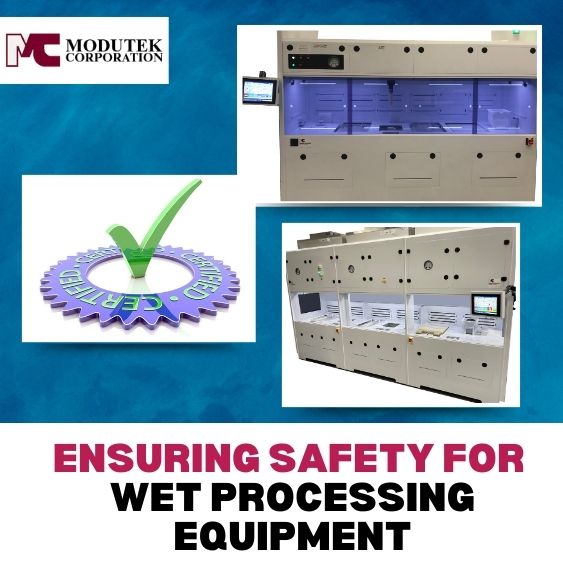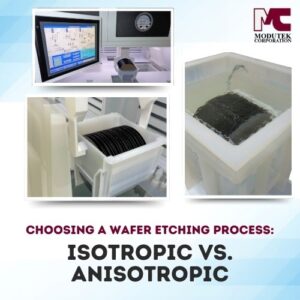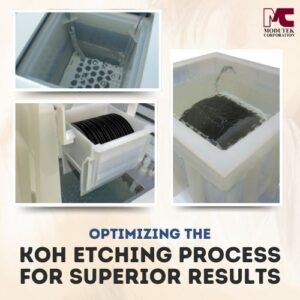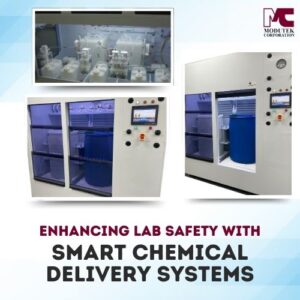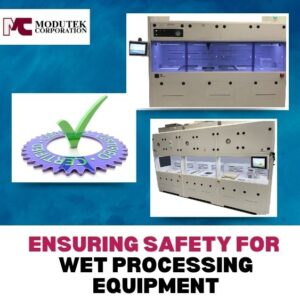 Safety is paramount in semiconductor manufacturing, where wet processing equipment is essential for various fabrication processes. Facility managers overseeing these operations must prioritize rigorous safety standards to mitigate the inherent risks of handling chemicals and operating specialized machinery. The hazards linked to wet bench equipment, such as chemical exposure, fire hazards, and equipment malfunctions, necessitate a comprehensive approach to safety. Implementing high standards and adhering to industry regulations are crucial for protecting personnel and equipment. By understanding and applying these safety measures, facility managers can ensure a safer and more efficient manufacturing environment.
Safety is paramount in semiconductor manufacturing, where wet processing equipment is essential for various fabrication processes. Facility managers overseeing these operations must prioritize rigorous safety standards to mitigate the inherent risks of handling chemicals and operating specialized machinery. The hazards linked to wet bench equipment, such as chemical exposure, fire hazards, and equipment malfunctions, necessitate a comprehensive approach to safety. Implementing high standards and adhering to industry regulations are crucial for protecting personnel and equipment. By understanding and applying these safety measures, facility managers can ensure a safer and more efficient manufacturing environment.
Understanding the Basics of Safety Standards in Wet Processing Equipment
Safety in semiconductor manufacturing is paramount, especially when it involves wet processing equipment. Wet bench stations and other wet processing systems are critical components in semiconductor fabs, yet they present several hazards that must be meticulously managed. For facility managers, ensuring these systems comply with rigorous safety standards is essential to maintain operational integrity and protect personnel and equipment.
Essential safety standards for wet bench and wet processing equipment in semiconductor manufacturing include FM4910, which specifies fire-retardant materials. For acid stations, using FM4910-compliant materials significantly reduces the risk of fire. These materials are designed to minimize the spread of flames and emit less smoke, thus providing a safer working environment. This compliance is critical as acid stations handle highly corrosive and potentially hazardous chemicals.
Similarly, solvent stations must adhere to Class 1 Div 2 standards, which address safely handling flammable liquids. Equipment that meets these standards is designed to prevent ignition of vapors, thereby reducing the risk of fire and explosion. This is particularly important in environments where solvents are used in significant quantities, posing a considerable fire hazard.
In addition, UL listings and other industry certifications play a vital role in ensuring the safety and compliance of wet processing equipment. These certifications verify that the equipment has undergone rigorous testing and meets established safety criteria. By choosing UL-listed equipment, facility managers can be assured of its reliability and safety performance. Incorporating these standards and certifications into selecting and maintaining wet processing equipment ensures compliance with safety regulations and enhances the overall safety of semiconductor manufacturing operations.
The Critical Role of Fire Safety Systems
Fire safety is critical to ensuring the safety and functionality of semiconductor manufacturing facilities. Fire risk is ever-present in environments where solvents and other flammable materials are used. Implementing effective fire safety systems is essential to protect the equipment and personnel in these facilities.
CO2 Fire Suppression for Solvent Systems
CO2 fire suppression systems are highly effective for solvent systems in semiconductor manufacturing. Unlike traditional water-based systems, CO2 systems protect sensitive equipment and do not cause water damage. CO2 extinguishes fires by displacing oxygen, quickly suppressing flames without leaving any residue. This method is particularly beneficial in semiconductor environments where even minor contamination can lead to significant operational issues.
Benefits of CO2 Systems for Solvent Benches
The advantages of using CO2 fire suppression systems for solvent benches include:
- Minimal Equipment Damage: CO2 is a dry extinguishing agent that avoids the water damage associated with traditional fire suppression methods.
- Rapid Fire Suppression: CO2 systems can quickly bring fires under control, reducing the risk of large-scale damage and downtime.
- No Residue: CO2 leaves no residue, eliminating the need for extensive cleanup and reducing the risk of contaminating sensitive semiconductor processes.
Compliance with Fire Safety Regulations
Adhering to fire safety regulations is mandatory for semiconductor manufacturing facilities. Regular system testing and maintenance are vital to ensure the fire suppression systems are functioning correctly and ready to operate in an emergency. Compliance with these regulations safeguards the facility and helps avoid legal and financial penalties.
By integrating CO2 fire suppression systems and maintaining compliance with fire safety regulations, facility managers can significantly enhance the safety of their wet processing equipment and overall manufacturing operations.
Ensuring Compliance through Certified Equipment
Choosing equipment that meets stringent industry certifications is crucial for maintaining safety and reliability in semiconductor manufacturing. Certified equipment ensures that the machinery used in wet processing meets the highest standards of safety, performance, and regulatory compliance.
Importance of Industry Certifications
Industry certifications such as Class 1 Div 2 for solvent stations and FM4910 for acid stations are vital for minimizing risks in semiconductor environments. These certifications indicate that the equipment has been tested and proven to meet specific safety criteria, reducing accidents and ensuring smoother operations.
Modutek’s Compliance with Safety Standards
Modutek’s wet processing equipment is designed and manufactured to meet these high safety standards. It is certified to meet various industry requirements, ensuring safety and operational efficiency. For example, Modutek’s wet processing equipment is constructed using FM4910 materials, which significantly reduces fire risks in acid processing environments. Additionally, our solvent stations comply with Class 1 Div 2 standards, making them safer to use in potentially hazardous conditions.
Examples of Certified Equipment
Modutek offers a range of equipment that meets these stringent safety standards, including:
- Acid Stations: Constructed with FM4910 materials to minimize fire hazards.
- Solvent Stations: Designed to comply with Class 1 Div 2 standards for enhanced safety.
- Custom Wet Processing Stations: Tailored to meet specific customer requirements while adhering to industry certifications.
By choosing certified equipment from Modutek, facility managers can ensure that their wet processing operations are safe, reliable, and compliant with industry standards. This protects the facility and its personnel and improves the efficiency and productivity of silicon wafer processing by incorporating the latest safety standards and technologies.
Practical Steps for Implementing Effective Safety Protocols
Implementing effective safety protocols is essential for maintaining a safe and productive semiconductor manufacturing environment. Facility managers must take a proactive approach to ensure that all safety measures are in place and that equipment is maintained and operated correctly.
Best Practices for Installing and Maintaining Safety Equipment
Proper installation and regular maintenance of safety equipment are crucial for preventing accidents and ensuring optimal performance. Here are some best practices to consider:
- Regular Inspections: Conduct routine inspections to identify and address potential safety hazards. This includes checking for leaks, ensuring that safety devices function correctly, and verifying that all equipment meets the required safety standards.
- Scheduled Maintenance: Implement a maintenance schedule that includes regular servicing and calibration of equipment to ensure it operates safely and efficiently. This helps identify wear and tear that could lead to equipment failure.
- Proper Documentation: Maintain detailed records of all safety inspections, maintenance activities, and incidents. This documentation can help track the performance of safety protocols and identify areas for improvement.
Importance of Proper Operator Training
Ensuring operators are adequately trained is fundamental to maintaining a safe working environment. Training programs should cover:
- Equipment Operation: Operators should be thoroughly trained to use the equipment safely and efficiently. This includes understanding the safety features and knowing how to respond in an emergency.
- Safety Procedures: Training should emphasize the importance of following established safety procedures, including the proper use of personal protective equipment (PPE) and adherence to safety protocols.
- Emergency Response: Operators should be trained in emergency response procedures, including how to shut down equipment safely and evacuate the area if necessary.
Modutek offers in-house training programs to help facility managers ensure their teams are well-prepared to safely and effectively operate wet processing equipment. Our comprehensive training covers all aspects of equipment use and safety, ensuring operators have the knowledge and skills to maintain a safe working environment.
Strategies for Ongoing Compliance Monitoring and Safety Audits
To maintain ongoing compliance with safety standards, facility managers should implement strategies for continuous monitoring and regular safety audits. These strategies include:
- Real-Time Monitoring: Utilize advanced monitoring systems to track the performance and safety of wet processing equipment in real time. This helps quickly identify and address any issues that arise.
- Safety Audits: Conduct regular safety audits to evaluate the effectiveness of existing safety protocols and identify areas for improvement. These audits should be comprehensive and involve a thorough review of all safety practices and equipment.
- Feedback Mechanisms: Establish mechanisms for operators to provide feedback on safety practices and report any concerns. This feedback can be invaluable in identifying potential safety issues and improving protocols.
Leveraging Technology for Enhanced Safety and Efficiency
Advanced technology is pivotal in enhancing safety and operational efficiency in semiconductor manufacturing. By integrating state-of-the-art systems and equipment, facility managers can create safer environments and optimize manufacturing processes.
Advanced Technologies for Safety Enhancement
Advanced wet processing equipment incorporates several advanced technologies designed to improve safety. These technologies include:
- Automated Monitoring Systems: Real-time monitoring systems continuously oversee equipment performance and safety conditions. Automated alerts notify operators of potential hazards, allowing for quick intervention and reducing the risk of accidents.
- Remote Diagnostics and Control: Advanced diagnostic tools enable remote monitoring and control of equipment. This capability allows facility managers to identify and address issues without being physically present, ensuring timely maintenance and reducing downtime.
- Integrated Safety Features: Equipment designed with built-in safety features, such as automatic shut-off mechanisms and chemical leak detectors, enhances operator safety and prevents potential hazards.
Efficiency through Technology Integration
In addition to enhancing safety, advanced technologies also contribute to increased operational efficiency. Some key benefits include:
- Process Automation: Automating repetitive and complex tasks reduces human error and increases consistency in manufacturing processes. This leads to higher yield rates and improved product quality.
- Data Analytics: Leveraging data analytics enables facility managers to gain insights into equipment performance and process efficiency. By analyzing this data, managers can make informed decisions to optimize operations and predict maintenance needs, minimizing unexpected downtime.
- Energy Management: Advanced energy management systems help reduce energy consumption by optimizing the operation of wet processing equipment. This not only lowers operational costs but also contributes to sustainability efforts.
Modutek’s Commitment to Safety and Efficiency
Modutek’s wet processing equipment is designed to incorporate the latest technologies, ensuring compliance with safety standards while enhancing operational efficiency. Our equipment includes automated chemical handling systems, real-time monitoring, and advanced safety controls, providing facility managers with the tools to maintain a safe and efficient manufacturing environment.
Conclusion
Maintaining safe operations in semiconductor manufacturing requires adhering to stringent standards and selecting the right equipment. Properly maintained wet processing equipment will reduce risks and enhance operational efficiency. Modutek provides high-quality, certified systems and equipment to meet industry standards and improve manufacturing efficiency. Our solutions, including FM4910 acid stations and Class 1 Div 2 solvent stations, ensure compliance and safety. Comprehensive training programs further support your team in maintaining a safe working environment.
Partnering with Modutek ensures access to the latest safety standards and technologies for facility managers seeking to optimize their operations. Contact Modutek for a free consultation and to discuss how our advanced wet processing equipment is designed to enhance your facility’s safety and efficiency.

